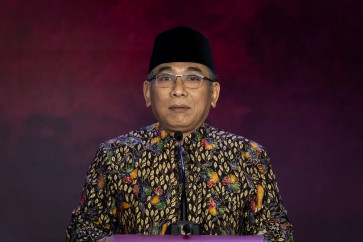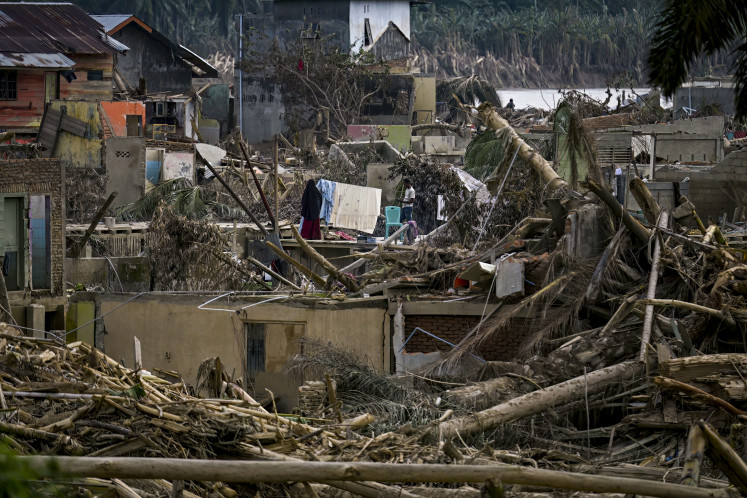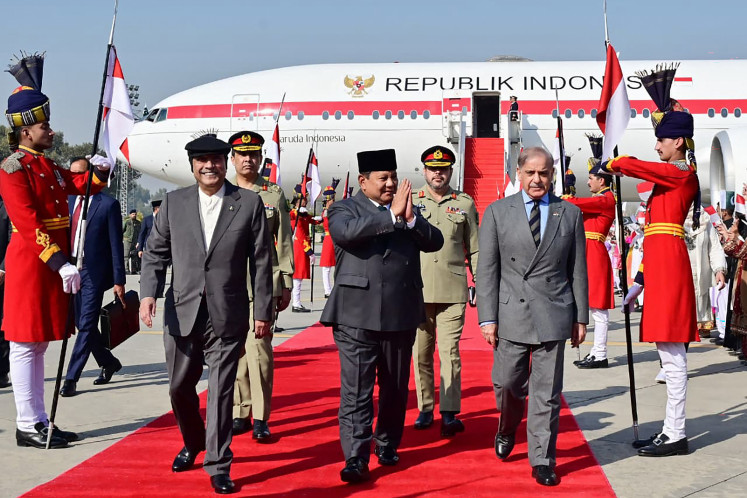Popular Reads
Top Results
Can't find what you're looking for?
View all search resultsPopular Reads
Top Results
Can't find what you're looking for?
View all search resultsPresident Jokowi's infrastructure projects: Quantity vs quality
President Joko âJokowiâ Widodoâs much awaited plans to implement massive infrastructure projects have started to take shape with the approval of the revised 2015 state budget by the House of Representatives
Change text size
Gift Premium Articles
to Anyone
P
resident Joko 'Jokowi' Widodo's much awaited plans to implement massive infrastructure projects have started to take shape with the approval of the revised 2015 state budget by the House of Representatives.
The government plans to spend Rp 290 trillion (US$23.2 billion) on infrastructure this year. By any standard it is a huge amount. It will be more than 60 percent higher than spending in 2014, and almost double the amount spent in 2013. It will be 2.4 percent of the gross domestic product (GDP). In the last five years, spending for infrastructure by the government has been stagnant at an average of 1.6 percent of GDP.
The question is, will government bureaucracies be able to spend that huge amount of money this year? Many hurdles still stand in the way of the implementation of these projects. Mechanisms for tendering, procurement procedures, finalizing contractual arrangements, coordination between several ministries , agencies and provincial and district governments whose roles in infrastructure building have been growing since decentralization in 2001, need to be refined to pave the way for the smooth implementation of these infrastructure projects. Legal and regulatory frameworks have to be improved.
Despite the revised law and two presidential regulations on land acquisition, many investors still face hurdles in acquiring land for infrastructure projects.
Over the next five years the government aims to build 5,000 km of railways, 2,600 km of roads, 1,000 km of toll roads, 49 dams and 24 seaports as well as construct power plants with a combined capacity of 35,000 megawatts.
Infrastructure investment has significant positive impact on long term economic growth. Infrastructure increases productivity, attracts business activity by lowering transportation and production costs and facilitates market access.
Well-functioning infrastructure enables the population to better access key services and economic opportunities, enhances firms' productivity and competitiveness, stimulates domestic and foreign investment, integrates domestic markets and connects them at a low cost to international markets.
Growth pay-offs from more investment in infrastructure can be sizable. Recent research from the Organization of Economic Cooperation and Development (OECD), which examines the link between infrastructure investment (including repair and maintenance) and GDP performance, reveals that physical infrastructure investment can boost long-term economic output more than other kinds of physical investment. In China, for instance, a 10 percent increase in infrastructure stock is associated with a 2 to 4 percent increase in GDP.
One of the highlights of the government infrastructure project is the planned construction of 1,000 km of toll roads, since they are considered to be projects that would readily relieve traffic congestion, speed up road transportation and increase economic activities in the areas through which they pass.
However, construction of toll roads has been exceedingly slow. Some highway concessions have not reached financial closure even after 10 years have elapsed. Indonesia started building toll roads in 1978. But 36 years on, not more than 1,000 km of toll roads have been built and operational. This means Indonesia built toll roads only 27 km a year since 1978. Compare this with India, which added 11 km of toll road a day on average.
One feature that has been included in the toll road construction project was the involvement of the private sector in the scheme known as public private partnership (PPP). Although progress has been made recently in streamlining the legislative and institutional frameworks for toll roads, the implementation of PPP projects have continued to be constrained by complex land acquisition processes, weak project preparation and selection as well as insufficient mechanisms for funding the projects.
In 2010-2011, Indonesia implemented two PPP projects worth $3.4 billion, compared with India, which, during the same period, implemented 95 PPP projects to the tune of $72 billion.
One of the factors slowing the implementation progress of PPP is that many PPP projects are being offered with inadequate background analysis prior to the tendering.
While convening international forums could be a useful way of promoting PPP projects, focusing on the most strategic and viable projects and getting them implemented could send a powerful signal to private investors concerning the government's commitment to implement PPPs.
This is a better way to attract private sector interest in PPP projects than organizing international gatherings, as the government was fond of in the past. The government has organized four infrastructure summits since 2005, but so far the result has been dismal.
While much focus is on the amount of spending on infrastructure investment, there should also be emphasis on the quality and efficiency of this investment.
Remember, Rp 290 trillion is a huge amount, and given the poor governance of many government institutions, and given the pressure to spend the allocated budget on time, the risk is very high that some of this money will go to waste, producing physical output with poor and sub-standard quality.
It is not just the new investment in infrastructure that counts, but also how the existing infrastructure assets could be maintained and serviced to extend their life and quality. Otherwise a substantial level of gross investment is needed just to cover the depreciation of, let alone the increase of, infrastructure capital stocks.
According to the World Bank, data from the Ministry of Public Works showed that the cost of periodic maintenance for Indonesian roads has averaged nearly $160,000 per km, well above international range of $70,000'$100,000 per km. This high cost of maintenance was the result of the poor quality of work, which was caused by a lack of quality assurance and corruption.
The economy and the people have suffered from the shortage of infrastructure. With boosts in infrastructure spending this year, expectations are high that this time the government could make a breakthrough in tackling infrastructure problems. President Jokowi should institute controlling and monitoring mechanisms in his infrastructure projects to ensure that the hundreds of trillions of rupiah that are meant for infrastructure will not go to waste.
___________________
The writer is a graduate of the school of economics at the University of Indonesia and a commissioner at a publicly listed oil and gas service company










